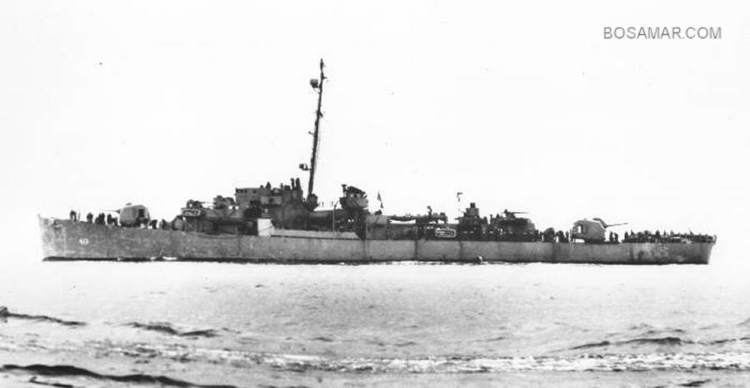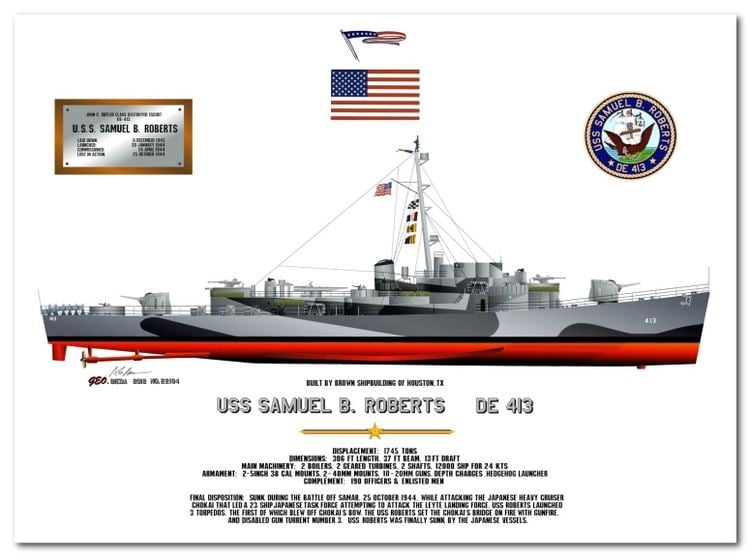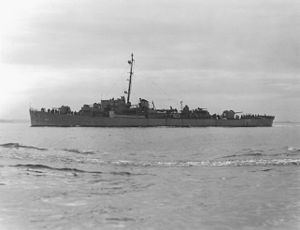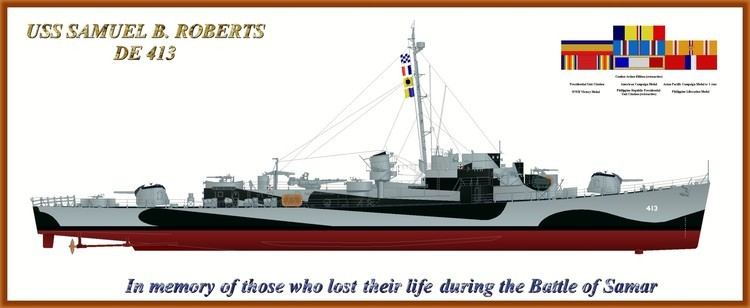Name USS Samuel B. Roberts Commissioned 28 April 1944 Launched 20 January 1944 | Laid down 6 December 1943 Construction started 6 December 1943 Length 93 m | |
 | ||
Namesake Samuel Booker Roberts, Jr. Builders | ||
USS Samuel B. Roberts (DE-413) was a John C. Butler-class destroyer escort of the United States Navy.
Contents
Samuel B. Roberts participated in the Battle off Samar, an unlikely victory in which relatively light U.S. warships prevented a vastly superior Japanese force from attacking the amphibious invasion fleet off the large Philippine island of Leyte. This destroyer escort, along with the handful of destroyers, destroyer escorts, and escort carriers of the unit called "Taffy 3", was inadvertently left alone to fend off a fleet of heavily armed Japanese battleships, cruisers, and destroyers in this crucial action off the Island of Samar, during the Battle of Leyte Gulf of October 1944. Steaming aggressively through a gauntlet of incoming shells, Samuel B. Roberts scored one torpedo hit and numerous gunfire hits as she slugged it out with larger enemy warships before finally being sunk. After the battle, Samuel B. Roberts received the appellation "the destroyer escort that fought like a battleship."

The ship was named for Coxswain Samuel Booker Roberts, Jr., a Navy Cross recipient, who had been commended for voluntarily steering a Higgins boat towards enemy forces, in order to divert fire from evacuation efforts being undertaken by other friendly vessels. Samuel B. Roberts was laid down on 6 December 1943, at the Brown Shipbuilding Company of Houston, Texas. She was launched on 20 January 1944, sponsored by Mrs. Roberts, and was commissioned on 28 April 1944, commanded by Lieutenant Commander Robert W. Copeland, USNR. She was the first of three U.S. Navy ships to bear her name.

Service history

Samuel B. Roberts had a shakedown cruise off Bermuda from 21 May – 19 June 1944. After spending time at Boston Navy Yard, Roberts departed for Norfolk, Virginia on July 11. Roberts departed Norfolk 22 July going through the Panama Canal 27 July. She joined the Pacific Fleet at Pearl Harbor on 10 August.

Samuel B. Roberts conducted training exercises around the Hawaiian Islands, and then steamed out on 21 August with a convoy that reached Eniwetok Atoll on 30 August. On 2 September, Roberts steamed back to Pearl Harbor, arriving there with a convoy on 10 September. Following further training, the destroyer escort got underway on 21 September, escorted a convoy to Eniwetok, and arrived on 30 September. Roberts next proceeded to Manus Island in the Admiralty Islands of the Southwest Pacific, and then joined Task Unit 77.4.3, nicknamed "Taffy 3". From there she steamed to the Leyte Gulf area off the eastern Philippines, and upon arrival, she commenced operations with the Northern Air Support Group off the Island of Samar.
The Battle off Samar
Shortly after dawn on 25 October, Samuel B. Roberts was protecting Taffy 3's small escort carriers. These were serving as bases for small bombers and fighters that were supporting the Army assault. These warships were steaming off the eastern coast of Samar when the Japanese Center Force — a 23-ship task force under the command of Vice Admiral Takeo Kurita — suddenly appeared on the horizon and opened fire. At 07:35, Roberts turned and headed toward the battle. She charged toward the heavy cruiser Chōkai. The commanding officer, Copeland, announced "We're making a torpedo run. The outcome is doubtful, but we will do our duty." With smoke as cover, Roberts steamed to within 2.5 nmi (4.6 km; 2.9 mi) of Chōkai, coming under fire from the cruiser's forward 8 in (203.2 mm) guns.
Roberts had moved so close that the enemy guns could not depress enough to hit her and the shells simply passed overhead. Many hit the carrier Gambier Bay. Once within torpedo range, she launched her three Mark 15 torpedoes. One blew off Chōkai's stern. The American sailors cheered "that a way Whitey, we hit 'em" as if it were a ballgame, as shells were still incoming. Roberts then fought with the Japanese ships for a further hour, firing more than six hundred 5 in (127.0 mm) shells, and while maneuvering at very close range, mauling Chōkai's superstructure with her 40 mm and 20 mm anti-aircraft guns. At 08:51, the Japanese landed two hits, the second of which damaged the aft 5 inch gun. This damaged gun suffered a breech explosion shortly thereafter which killed and wounded several crew members. With her remaining 5 in (127.0 mm) gun, Roberts set the bridge of the heavy cruiser Chikuma on fire and destroyed the Number Three gun turret, before being hit by three 14 in (355.6 mm) shells from the battleship Kongō. The shells tore a hole 40 ft (12.2 m) long and 10 ft (3.0 m) wide in the port side of her aft engine room.
Gunner's Mate Third Class Paul H. Carr was in charge of the aft 5 in (127.0 mm) gun mount, which had fired nearly all of its 325 stored rounds in 35 minutes before a breech explosion. Carr was found dying at his station from a severe intestinal wound, begging for help to load the last round he was holding into the breech. He had scored a great many hits on the heavy cruiser Chokai, also sunk that day. He was posthumously awarded a Silver Star, and a guided missile frigate was later named for him. The guided missile frigates Samuel B. Roberts and Copeland were also named for the ship and its captain. At 09:35, the order was given to abandon ship. She sank 30 minutes later, with 90 of her sailors.
The 120 survivors of the crew clung to three life rafts for 50 hours before being rescued. During the battle, Samuel B. Roberts — designed for 23–24 kn (43–44 km/h; 26–28 mph) — reached 28.7 kn (53.2 km/h; 33.0 mph) by diverting all available steam to the ship's twin turbines.
Samuel B. Roberts was struck from the Naval Vessel Register on 27 November 1944.
Awards
Samuel B. Roberts was included in the Presidential Unit Citation given to Task Unit 77.4.3 "for extraordinary heroism in action." Samuel B. Roberts earned one battle star for her World War II service.
Memorials
At the U.S. Naval Academy, in Alumni Hall, a concourse is dedicated to Lieutenant Lloyd Garnett and his shipmates on Samuel B. Roberts who earned their ship the reputation as the "destroyer escort that fought like a battleship" in the Battle of Leyte Gulf.
Successors
Three ships of the United States Navy have borne the name USS Samuel B. Roberts, in honor of Samuel B. Roberts.
In popular culture
The television show Star Trek Deep Space 9 featured a starship named "Samuel B. Roberts" in the 1999 episode "What You Leave Behind". The Miranda-class cruiser appears briefly as a background ship during the final battle of the Dominion War.
The ship has been subject of scale model kits:
